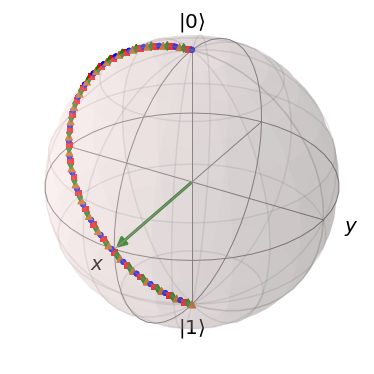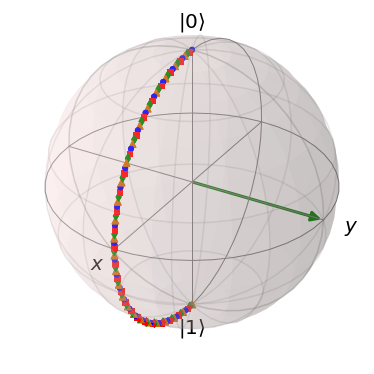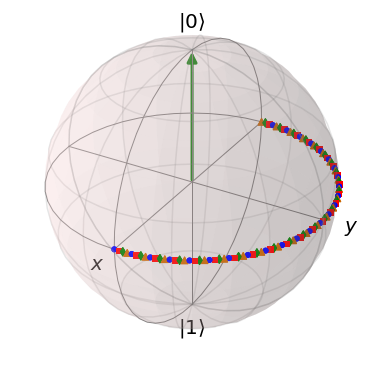Chapter 1b: Usefull Toolbox
1.6. Bloch Sphere:
- Because in my class there are a lot of non-physicists I thought it would be useful to introduce the concept of the Bloch Sphere.
- Bloch Sphere is just a common representation of a two level system, which allows one to think about the states and operations in a more intuitive way
- Normally when one thinks about how many parameters one needs to define a two level system, they can naively thing 4. In the end two level system lives in \(\left|\psi\right> \in \mathbb{C}^2\). In different words, any pure state can be written as a superposition of the basis vectors \(\left|0\right>\) and \(\left|1\right>\), where the coefficient of each of the two basis vectors is a complex number. \(\left|\psi\right> = a_1e^{i\theta_1} \left|0\right> + a_2e^{i\theta_2} \left|1\right>\). 4-parameters right?
- We know, however, that the norm of a pure state must equal to 1, which means that $\left<\psi|\psi\right> = 1 $, and so \(\left|a_1\right|^2 + \left|a_2\right|^2=1\). This reduces the number of free parameters to 3
- We also know that we dont care about the global phase of a state, as it doesn't change anything about our measurement, and so we can also neglect one degree of freedom, which reduces the number of free parameters to 2
- This means that we can represent any 2-level quantum pure state on a unit sphere, which we will call Bloch Sphere
- How does one parametrise something on a unit-sphere?
- One can do it with angles, \(\theta \text{ and } \phi\)
- \(\left|\psi\right> = \cos\frac{\theta}{2} \left|0\right> + e^{i\phi}\sin{\frac{\theta}{2}} \left|1\right>\)
- In such representation the probability of measuring state \(\left|0\right>\) is: \(\left<0|\psi\right> = \cos^2\frac{\theta}{2}\), and to measure state \(\left|1\right>\) is \(\sin^2\frac{\theta}{2}\)
- \(\left|\psi\right>\) can be represented on a unit sphere as:
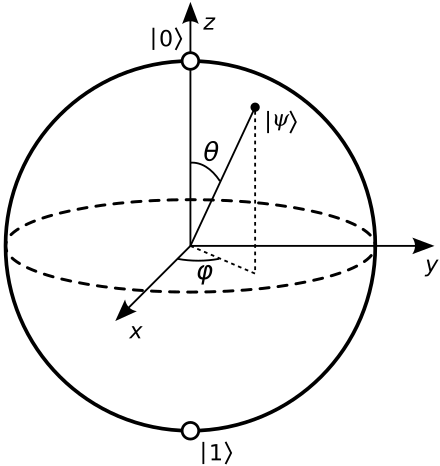 - Any Unitary Operator then will be some sort of rotation of this state, mapping it from one point on this sphere to another point on this sphere - you will see it in the subchapter Quantum Circuits
- Any Unitary Operator then will be some sort of rotation of this state, mapping it from one point on this sphere to another point on this sphere - you will see it in the subchapter Quantum Circuits
1.7. Bell Basis
- Let \(\mathcal{H}_{A B}=\mathcal{H}_A \otimes \mathcal{H}_B \cong \mathbb{C}^4\) be the bipartite Hilbert space of two qubits and consider the product basis of the computational bases of the qubit subsystems. For \(\mathcal{H_{AB}}\) there exists a basis consisting of maximally entangled states denotes as:
\[\begin{array}{ll}\left|\psi^{00}\right>=\frac{1}{\sqrt{2}}(\left|00\right>+\left|11\right>) & =\left|\Phi^{+}\right> \\ \left|\psi^{01}\right>=\frac{1}{\sqrt{2}}(\left|00\right>-\left|11\right>) & =\left|\Phi^{-}\right> \\ \left|\psi^{10}\right>=\frac{1}{\sqrt{2}}(\left|01\right>+\left|10\right>) & =\left|\Psi^{+}\right> \\ \left|\psi^{11}\right>=\frac{1}{\sqrt{2}}(\left|01\right>-\left|10\right>) & =\left|\Psi^{-}\right>\end{array}\]
- The first number stands for parity, the second number stands for phase. \(\left|\psi^{10}\right>\) has parity 1 (odd number of 1's), and relative phase \((-1)^0=1\)
- The maximally entangled states are locally convertible - there exist local operations on the subsystem B that transforms one Bell state into another Bell state. \(\(\left|\psi^{i j}\right>=\left(\mathbb{I}_A \otimes X_B^i Z_B^j\right)\left|\psi^{00}\right>\)\)
1.8. Quantum Circuits
Example Quantum circuit
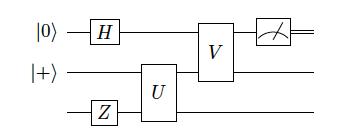
corresponds to unitary operator \(\left(V \otimes \mathbb{I}\right)\left(\mathbb{I}\otimes U\right)\left(H\otimes\mathbb{I}\otimes Z\right)\) applied to three qubits followed by a Z-measurement of the first qubit
Common Gates
- Haddamard Gate:
- \(H=\frac{1}{\sqrt{2}}\left(\begin{array}{cc}1 & 1 \\ 1 & -1\end{array}\right)=\left|+\right>\left< 0\right|+\left|-\right> \left<1\right|=\left| 0\right>\left<+\right|+\left| 1\right>\left<-\right|\)
- As an orthogonal transformation in the real Euclidean plane \(\mathbb{R}^2\), H is reflection in the mirror line at angle \(\frac{\pi}{8}\) to the x-axis
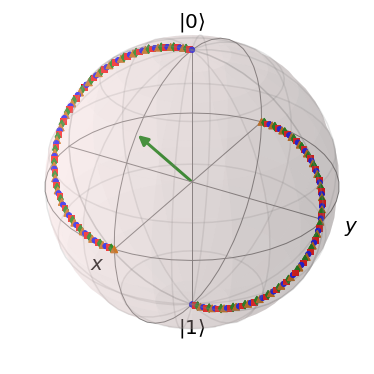
- X, Y, Z:
- \(X = \left(\begin{array}{ll} 0 & 1 \\ 1 & 0 \end{array}\right)\), \(Z = \left(\begin{array}{ll} 1 & 0 \\ 0 & -1 \end{array}\right)\), \(Y = \left(\begin{array}{ll} 0 & 1 \\ -1 & 0 \end{array}\right)\)
- X-gate
- Y-gate
- Z-gate
- Controlled-U Gate:
- \(\mathrm{C} U=\left|0\right>\left<0\right|\otimes \mathrm{id}+\left| 1\right>\left<1\right| \otimes U\)
- Controlled-Not Gate:
- \(\mathrm{CNOT}=\left(\begin{array}{llll}1 & 0 & 0 & 0 \\ 0 & 1 & 0 & 0 \\ 0 & 0 & 0 & 1 \\ 0 & 0 & 1 & 0\end{array}\right)=\left|0 \right>\left< 0\right| \otimes \mathbb{I}+\left|1\right>\left<1\right| \otimes X\)
